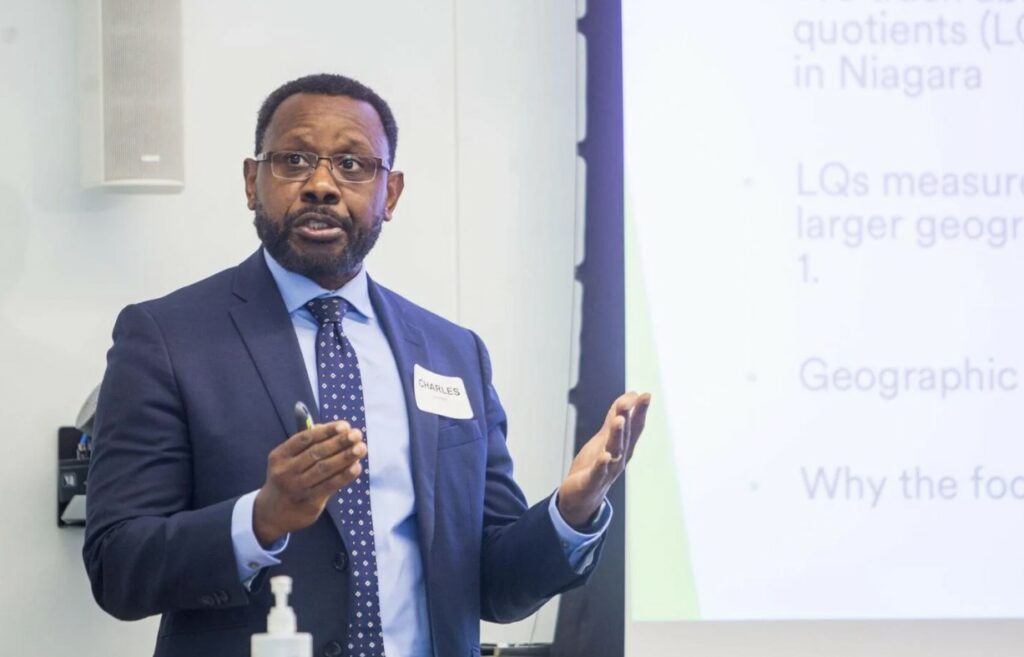Source: The Standard
A multi-year research project into Niagara’s history and economic development in its initial stages has found the region “has punched well above its weight in helping to shape and enrich Canada into the nation we know today.”
The project comes from a multi-year partnership between Brock University and the Wilson Foundation, facilitated by Brock’s Niagara Community Observatory (NCO), with the goal of mapping Niagara’s history and deepening understanding of the region’s economic and social development.
Economic developers, historians, educators, business leaders and experts gathered for a closer look at the team’s initial findings this week for its project called Mapping the Economic History and Assets of Niagara in a Changing World.
The goal was to receive feedback on research to date.
“It has been a lively, very instructive conversation,” said Charles Conteh, director of NCO and principal investigator of the project.
“I’m very excited of the fact that this is not an ivory-tower project, some bunch of experts at Brock sitting down and telling the region’s stories. But we can stop, bring in the experts from the trenches and say ‘Does that reflect you’ and they can speak back.
“My hope is that they will help us do justice to it.”
The idea for the project started when the Wilson Foundation asked for a comprehensive story of Niagara as an economic space, as a community and as a prosperous region. It was asked to research Niagara’s history, what makes it unique, to “understand why the region is what it is today.”
Conteh said the university took the foundation’s idea, consulted with local partners and created a project that aims to do justice to each sector.
From there, researchers worked alongside partners in Brock’s development and donor relations and archives and special collections departments who provided data.
The project is led by six Brock faculty members and Conteh, a professor of public policy and management, who said he was “drawing from the expertise of my colleagues in history and economics, in sociology and other disciplines to tell this comprehensive story of Niagara.”
That meant capturing key economic drivers — what Conteh called the “lifeblood of Niagara” — and studying those elements to tell the foundational story of Niagara from the early 1800s to present day. Examining critical moments, events, personalities, investors, visionaries, entrepreneurs and how, over time, those critical milestones helped inform decisions that shaped Niagara through six sectors: agribusiness, electric power generation, technology, manufacturing, marine commerce and tourism.
The initial findings revealed trends and histories about Niagara’s economic growth and sectors that drove its prosperity, and informed a story of a mid-sized region “that has punched well above its weight in helping to shape and enrich Canada into the nation we know today.”
It also linked and compared some numbers, such as employment and population changes, to local, national and global economic trends.
What became clear over many months could be summarized in a single sentence for Conteh: “Many rivers run through it.”
Niagara creeks, rivers and lakes are all “fundamentally, the critical building blocks and foundation that gives Niagara the peculiar space and development and history that it has, compared to any other place in Canada.”
“It’s a geographical location — its water system, its escarpment, the land, the contours (in Niagara) form that foundation for everything else,” he said.
“People, visionaries, entrepreneurs, investors, workers — across gender, across race — over time, at different points through different generations, came in and peopled the region and made it what it is today.”
Leveraging Niagara-specific assets, and the region’s ability to adapt and reinvent itself over time — particularly in moments of critical change, including seismic shifts in manufacturing, technology and tourism — gives the research team confidence the region has the same “staying power well into the future.”
“The one thing I look back at, the deeper we go in time, in history, the more we have the perspective to say confidently, unapologetically, without a caveat, that Niagara has demonstrated such resilience over time,” said Conteh.
This week’s presentation was split into two sections — key economic sector trends in Niagara in the 1800s to 1969, followed by 1969 to present.
A panel of experts from local industries, including Niagara Parks and Vineland Research and Innovation Centre, provided feedback as did workshop attendees.
Each shared thoughts on further research opportunities, such as the impact of air-based transportation in Niagara, and changes to agricultural land and productivity. Other suggestions included the impact of 9/11 in the early 2000s, leveraging the wine industry and the Shaw Festival as an anchor institution.
Also suggested were further comparisons of the pandemic impacts of 1918 compared with COVID-19 in 2020.
Conteh said the project is now focused on critical policy decisions.
“How are we positioning those sectors and our assets — human, physical, digital — for the future, to leverage national market opportunities, global markets,” said Conteh.
There is a plan to have another public session to launch final revised papers, likely this summer. All information will be available on the NCO website and in partnership with Brock’s library archives and special collections to make the work accessible as study material.
And more conversation is needed, specifically based on Niagara’s legacy of adaptability and reinvention.
“How are we projecting forward, how will we navigate forward, and the hope is to provide some commentary on things that we can do differently, things that we can do more, and things that we can add to it,” said Conteh.

